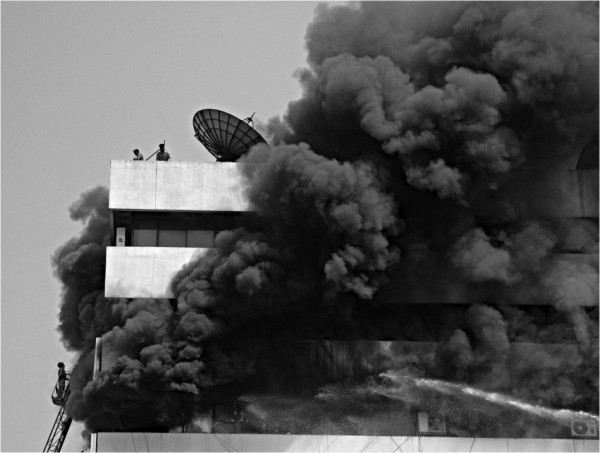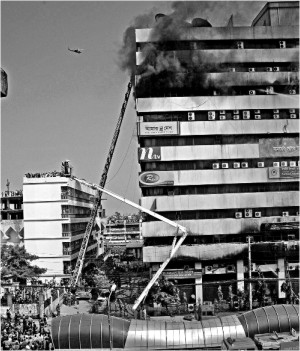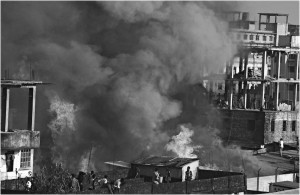

Photo: Liton Rahman/Driknews
Fire: Precautions and control
Dr. Nizamuddin Ahmed
In view of total disregard for fire prevention, precautions and control, as well as lack of awareness, workplaces are increasingly becoming dangerous. Women workers are particularly vulnerable in the garment industries, where several deaths have occurred. Legislation is lacking or poorly implemented. In designing buildings, architects do not consider fire as a factor. Misuse of electricity is a major cause of the deplorable situation. Fire-fighting equipment, training of personnel and regular drill for users are not in practice. Where available, equipment is outdated and inadequately maintained. Means of Escape are congested, obstructed with combustibles, inadequate in size, and inappropriately planned. The factories are in effect a death trap. Owners must be encouraged to provide safer work place. Industrialists must be willing to spend more on safety and security. Increasing awareness through the use of mass media could be a good starting point.
1. In Bangladesh, there is apparently only one problem regarding Fire Prevention, precautions and control. And that is lack of awareness regarding the dangers of fire. Here fire accidents are just waiting to happen.
2. The threat is more poignant in Dhaka because of more people, more buildings, and more ignorance.
3. People will die in a fire mainly because of the ensuing panic, smoke logging, and inability to escape.
4. Panic is an animal instinct that takes over in uncertain and hazardous situations like a fire, for which people are not trained or drilled. Smoke is the primary killer and can engulf a whole building if it is not compartmented. Escape in buildings in Bangladesh is made difficult because of over-zealous security measures added to ignorance. For instance:
a) stairways in a multi-storied buildings are often closed midway
b) path to a fire escape, if any, is blocked by a collapsible gate and a lock
c) escape route is littered with goods and rubbish
d) door of a designated fire escape remains locked at the ground floor
 |
Photo: Liton Rahman/Driknews |
5. Some factors responsible for the precarious situation regarding fire:
a) Ignorance and lack of awareness
b) Inadequate legislation
c) Ineffective implementation of legislation
d) Ineffective inspection by the Fire Services
e) Improper building plan
f) Provision of single outlet
g) Inadequate size of egress
h) Lack of escape route
i) Inability to escape unaided within 2.5 minutes
j) Escape routes hindered by congestion and sealed exits
k) Inappropriate signs/symbols
l) Inadequate smoke/fire detection and alarm systems
m) Unreliable and inefficient telephone system
n) Single staircase in multi-storied buildings
o) Unauthorised change in building use
p) Security measures driven to extremes
q) Improper electrical installation & lack of maintenance
r) Improper waste disposal
s) Careless use of heat appliances
t) Careless smoking habits
u) Lack of emergency training and drill
v) Lack of Assembly Point
6. Fire fighting in Bangladesh is hampered due to:
a) No in-house personnel delegated to take charge in case of a fire
b) Lack of fire fighting equipment
c) Out-dated/ ill-maintained/ inappropriate fire extinguisher; none trained to operate.
d) Non-segmentation of large building will make fire unmanageable
e) Fire will spread from one part to another
f) Shortage of water and means of spraying
g) Lack of fire drill will add to panic
h) Difficult for Fire Engines to reach affected building
7. According to a survey conducted at BUET, it will take at least 30 minutes by a Fire Services engine to reach 50% of the shopping centres in Dhaka during peak traffic hours.
8. The garment factories in Dhaka are being considered a case study for the purpose of this paper. This is the fastest growing industry in the country, accounting for about 60% of the export earning, employing 1.25 million workers, 80-85% of whom are women, many aged 14 or less.
9. As a result of the existing situation as mentioned above, garment factories in Dhaka have been witness to some grim fire accidents.
10. Some deaths from garment factory fires in Dhaka (list not exhaustive):
11. Workers are paying the penalty for employers' apathy.
12. The deaths can be avoided. The question is how many more deaths before garment factory owners realise their work places are virtual death traps?
13. Sequence of events in a fire are as follows:
a) Spark or noise or shouts of 'fire'
b) Ensuing panic because of large workforce in congested space
c) Subsequent stampede to flee because of fear and heat
d) Frantic jumps through windows and rooftops
e) 'No escape', as the only gate is locked or half-open
f) The 'darwan' (security) with the keys has escaped
g) Some are trampled in the stampede
h) Areas with combustible materials are quickly engulfed by flame and smoke
i) Inmates collapse due to lack of oxygen as is typical in any large fire
j) Short circuit ascribed as the cause of fire, as none can then be held responsible
k) The matter is forgotten as soon as order is received for next shipment
14. Following the death of workers the government has compelled factories to build a second staircase, as almost all are located in buildings with one staircase. These so-called fire escapes, made of mild steel, have many design faults:
a) Open and exposed to the weather
b) Attached to the building, although a gap of 1.8m is recommended.
c) Structurally weak with dangerous movement that could give way during escape of hundreds of workers.
d) Built like an upright ladder that would be perilous to ride at normal times.
15. Highlights garment factories could do without:
a) Residential buildings put to industrial use
b) Unauthorised change
c) Factory floor/ escape route packed with worktops and combustibles
d) Improper wiring and electrical design; illegal connections
e) Overzealous security measures, narrow exits fully/partially locked
f) Misuse of ironing and heating appliances
g) Improper disposal of waste
h) No precautions against fire, not even a single fire extinguisher
i) Large illiterate workforce without any fire training or drill
j) Escape difficult by one narrow staircase in multi-storied building
16. The attitude of concerned persons can be not be better epitomised than the following notice that is displayed in Bangla in cinema halls all over the country: (Translated, it roughly means)
 |
Photo: Jashim Salam/Driknews |
Notice
To ensure the safety of the audience, the Main Entry will remain locked during the interval.
Your co-operation is kindly solicited
With the thought of escape on your mind, you will never be less secure or safe.
17. To save lives, factory owners must ensure
a) safe working conditions
b) preventive measures; i.e. prevent the possibility of a fire
c) restricting the spread of fire and its containment at source
d) a Means of Escape in everyday use
e) for workers to reach a place of safety without the need to pass through smoke, heat and/or fire
f) adequate number of 'unlocked' doors located strategically
g) more budget on security to employ MORE guards for extra vigil, if pilferage is apprehended
h) precautionary measures, i.e. possess equipment and means of controlling fire
i) trained personnel to take charge in a fire regular drills for everyone
j) an Assembly Point away from the building where escapees will gather
k) development of liaison with the local Fire Services
18.The Bangladesh Garments Manufacturers and Exporters Association (BGMEA) and other organisations offer compensation to families of the dead. But, no death can really be compensated.
19.WHAT CAN WE DO?
a)increase awareness, through the electronic media, mass publicity and education
b) adopt measures to prevent fire from starting
c) enable people to escape unaided to a place of safety
d) ensure measures to control spread of fire and douse the fire
e) conduct regular drill
f) learn from other fire incidents
g) inform the worker about the perils, preventive measures, and Means of Escape
It may help to remember that the Fire Services are not meant to save lives immediately after a fire starts, but you can, we all can.
The paper was presented at the 9th International Conference on Safe Communities, 26-28 February 2000, Dhaka. The contents are by and large applicable to most buildings even in 2011.
The writer is Professor, Dept of Architecture, BUET, Dhaka, and Consultant on Urban Issues to The Daily Star Editor.